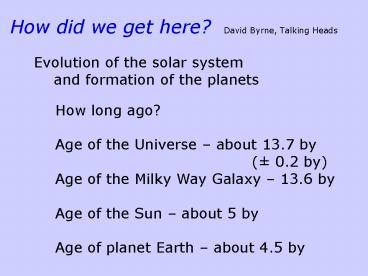How did we get here David Byrne, Talking Heads PowerPoint PPT Presentation
1 / 50
Title: How did we get here David Byrne, Talking Heads
1
How did we get here? David Byrne, Talking Heads
Evolution of the solar system and formation
of the planets
How long ago? Age of the Universe about 13.7
by ( 0.2
by) Age of the Milky Way Galaxy 13.6 by Age of
the Sun about 5 by Age of planet Earth about
4.5 by
2
A spiral galaxy similar to our own
56,000 light years across 62 million light years
away
3
Whats a light year?
186,000 miles / second X
60 seconds / minute X
60 minutes / hour 6.7 x
108 miles / hour
67 x 107 miles / hour
670 x 106 miles / hour
or 670 million miles / hour
X 24 hours / day X 365 days / year
5.8 x 1012 miles / year
4
The Milky Way Galaxy (center)
At least 200 billion stars possibly 400
billion 100,000 light years across 3.6 billion
years old
5
125 Billion Galaxies
6
The structure of the Universe
Galaxies organized into clusters and superclusters
7
Creating a star
Stellar nurseries in a nebula
8
Areas of intense star formation
text
9
The Crab Nebula
text
10
Igniting a star
Enough gas (mostly hydrogen) is pulled
together by gravity to form a dense mass
11
The star as a fusion reactor
Four protons (nucleus of hydrogen atoms)
under extreme pressure are pressed together to
create a helium nucleus this releases a
tremendous amount of energy as heat and
radiation
12
The interior of the star
also produces heavier elements Important
for the formation of planets Fe iron Si
silicon Mg magnesium O oxygen
13
A star explodes supernova
Hydrogen is used up Star collapses then
explodes Enormous pressure wave scatters
dust and gas
14
Iron from the star is critical for creating
new planets
15
Pre-Solar Nebula
16
Beginning of the Solar System
17
Orion Proto-Planetary Disk
18
Proto-planetary disks
19
Disk seen edge-on
Light of the star reflecting off disk
20
Accretion lumps form
21
Process of accretion
22
Process of accretion
planetesimals
protoplanet
23
text
24
(No Transcript)
25
(No Transcript)
26
(No Transcript)
27
Taurus disk
200 known planets outside our solar
system Several known multi-planet
systems Estimated 10 billion Earths in
Milky Way Galaxy
28
Asteroid belt
Similar to planetesimals
29
Asteroids
Many impacts
30
Small rocky bodies
text
31
The gas giants
text
32
Gravitational lens
Warping space-time
33
Earth and Moon
34
Creating the moon
Earth struck by another body, possibly as
large as Mars
35
(No Transcript)
36
Hot blobs in space
37
text
38
Violent early history
Earth was also pummeled
39
Basalt flows to the surface
Molten interior
40
Interiors of the Earth and Moon
41
text
42
text
43
text
44
text
45
(No Transcript)
46
(No Transcript)
47
text
48
End of a stars life
Expansion, burnout
49
the end
50
Gravitational lens

